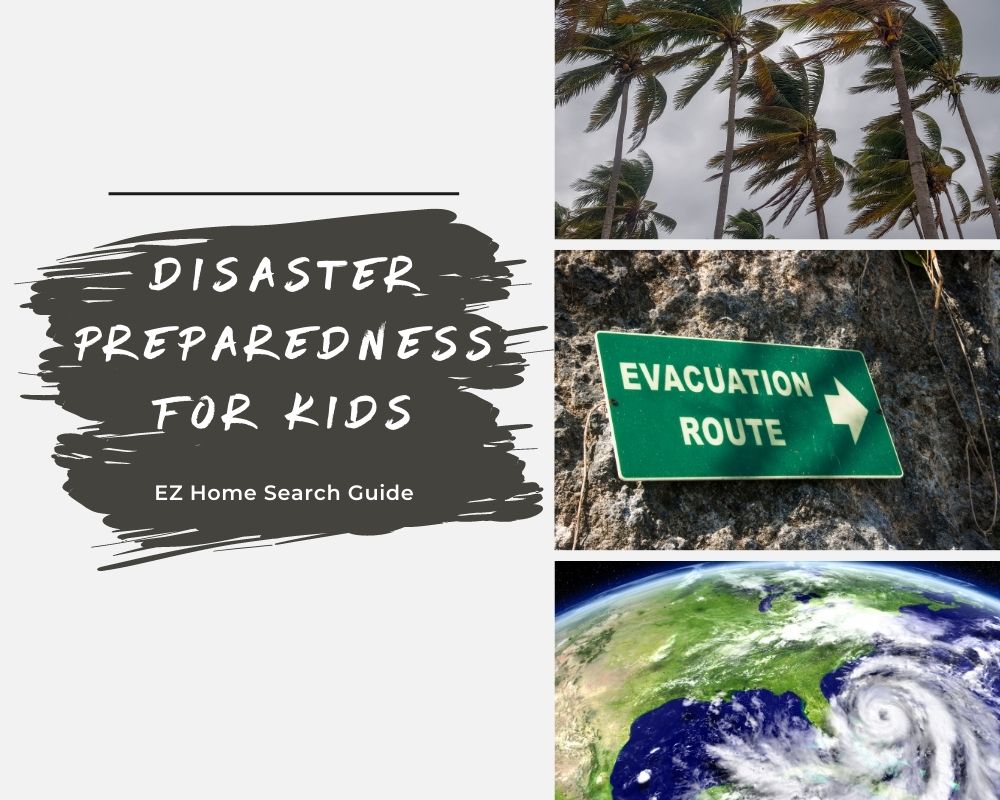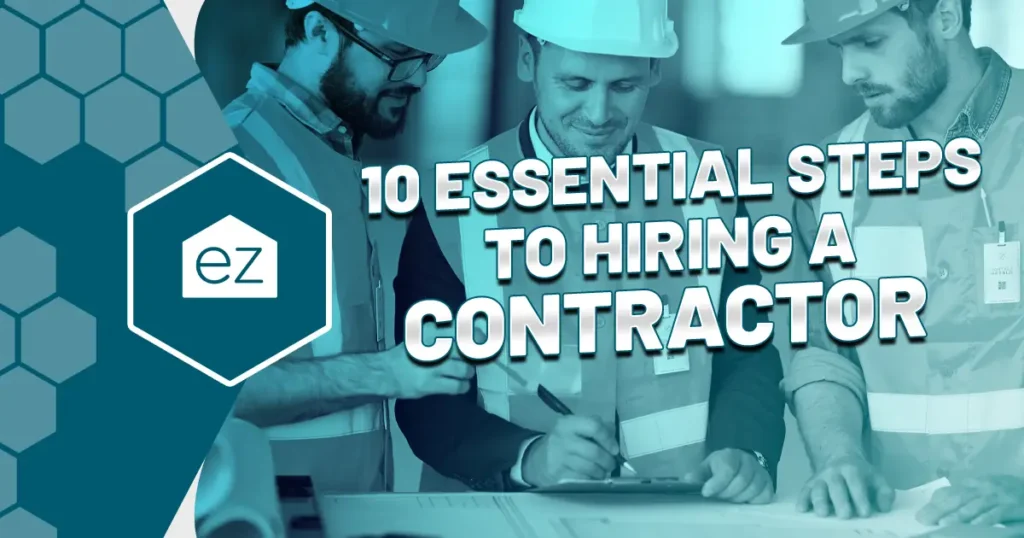Disaster Preparedness for Kids

Preparing Children for Natural Disasters at Home: A Guide for Parents
In 2020, there were a total of 416 natural disaster events worldwide. It is important to be aware that natural disasters can be costly — both for you and your family’s health and your possessions. Natural disaster risks fluctuate depending on where you live. For example, states that are located within the western United States are more prone to earthquakes because they are geographically located along the boundary of the North American plate where more faults have been formed.
When you move to a new place, it becomes increasingly important to understand the different natural disasters that you are most likely to encounter based on where you are geographically located. There are numerous different types of natural disasters. It is vital to understand specific information surrounding each respective type, and what you can do to better prepare your home and your family.
Teaching Kids About Different Natural Disasters
If you have children, it is just as important to teach them about the different types of natural disasters as it is for you to learn about them. When you teach your kids general information about natural disasters (e.g. what they are, what causes them, warning signs/how to identify them) they become better equipped to take action.
There are numerous options available that are dedicated to providing children with education about natural disasters. They aim to provide information at an appropriate level by using interactive media like games and helpful images to bolster a child’s understanding. Below is some foundational information about different types of common natural disasters and some examples of educational options that are designed to help teach your children about the different types of natural disasters.
Hurricanes
Hurricanes are large, wind-swirling storms that form from tropical storms. They develop over warm ocean waters and occasionally make it to land. Hurricanes can also cause tsunamis and floods. Florida, Texas, North Carolina, South Carolina, and Louisiana are the U.S. states that have been hit by hurricanes the most. There are five classifications of hurricanes and they are determined by wind speed — the five classifications are:
- Category 1: 74-95 mph winds;
- Category 2: 96-110 mph winds;
- Category 3: 111-129 mph winds;
- Category 4: 130-156 mph winds;
- Category 5: 157+ mph winds.
Listed below are some educational options on hurricanes aimed at children:
- Kids’ Crossing: Kids’ Crossing provides images, stories, activities, and hurricane safety tips to comprehensively educate children on hurricanes;
- Ready Wrigley: The U.S. Department of Health and Human Services created “Ready Wrigley,” which is a printable PDF booklet that educates children on hurricanes through coloring, word finds, mazes, and other educational games;
- Sesame Street: Sesame Street offers a printable hurricane guide for parents to go through with their children. This resource is aimed at equipping parents with the necessary skills and information to help children after a hurricane has occurred.
Tornadoes
Tornadoes are rotating columns made of air. They are generally connected to the base of a thunderstorm and can reach speeds up to 300 mph. Some tornadoes are visible from the dust, water, and debris they collect, while others are not. “Tornado Alley” is the nickname given to southern states because they experience a large number of tornadoes every year. The Enhanced Fujita scale — also called the “EF scale” — is used to classify the severity of the storm and the 0-to-five scale goes as follows:
- 0: 65 to 85 mph winds;
- 1: 86-110 mph winds;
- 2: 111-135 mph winds;
- 3: 136-165 mph winds;
- 4: 166-200 mph winds;
- 5: 200+ mph winds.
There are a few different educational resources below to help you teach your children about tornadoes, including:
- WeatherWizKids: WeatherWizKids provides useful information on their site for children to understand what to do before, after, and during a tornado. They even provide information for what to do if you are at school during a tornado;
- National Geographic Kids: National Geographic Kids includes various pictures and facts about tornadoes to help children understand more about them;
- Weather.gov: Weather.gov offers a printable PDF tornado weather book that consists of informational coloring and a tornado quiz to help children get a better understanding of tornadoes and helpful situational safety tips.
Floods
Floods are when water overflows into traditionally dry areas. They are considered the most common weather-related natural disaster and all areas are considered “at-risk” for floods. Note that highly-populated areas near water are generally more at risk because there are more contributors to flood risk. There are several causes of floods, some of the most common being:
- Heavy rains;
- Overflowing rivers;
- Broken dams;
- Urban drainage basins;
- Storm surges and tsunamis;
- Channels with steeps sides;
- Lack of vegetation;
- Melting snow/ice.
Flash floods are the most destructive type. They have the same properties as traditional floods, but they are more dangerous because of their speed. Even though a natural disaster can cause plumbing issues in your home, most household floods occur from some sort of plumbing issue or leak. It is increasingly important to equip your children with knowledge of what to do in a flood for this reason.
Below are some educational resources available that are targeted at children:
- Ready.gov Kids: Read.gov Kids provides risk factors, important words to be aware of, educational videos, and useful information for before, during, and after a flood that is aimed at children;
- KidsKonnect: KidsKonnect provides flood facts, worksheets, and safety information to help you educate your children on flood preparedness;
- CDC.gov: The CDC offers a downloadable/printable PDF to help educate children on various flood-related considerations. It contains an array of informational images and numerous activities for a fun, interactive way to learn about floods.
Wildfires
Wildfires are uncontrolled fires that burn throughout a variety of different ecosystems. Wildfires can start from weather-related sources like a lightning strike, but humans are the leading cause of wildfires in the U.S. — generally from a human-made spark (e.g. cigarette, uncontained fire, faulty wiring, etc.). Weather conditions can also contribute to wildfires once they have started. When there are high temperatures, high winds, dry land/plants, and minimal rainfall, this can create the perfect conditions for wildfires to spread.
Similar to floods, it is extremely important to educate your children on wildfires and fire safety since there are many ways that they can start. Below are some resources to help educate your children on wildfires and fire safety:
- USFA: The U.S. Fire Administration provides different information that you should pass onto your children like making an escape plan and fire safety considerations. The site also contains a fire safety activity book, and a fold-up fire truck activity sheet;
- Sparky: The National Fire Protection Association (NFPA) created “Sparky” to help educate children on fire safety through an array of informational videos, games, and activities;
- FireSafeKid: FireSafeKid offers various educational reading, graphics, presentations, and games to help educate children about fires.
Earthquakes
Earthquakes are a quick, sudden shaking of the earth. There are some cases where this is violent and powerful, and other times where it is unnoticeable. Earthquakes occur when two faults slip past one another. California, Missouri, South Carolina, Hawaii, Alaska, and the Coastal Pacific Northwest are common places for earthquakes. The following terms are important to understand:
- Hypocenter: The location where an earthquake starts below the surface;
- Epicenter: The location directly above the hypocenter where an earthquake starts above the surface;
- Foreshock: Smaller shaking that occurs before the primary earthquake;
- Mainshock: The biggest, primary earthquake;
- Aftershock: Smaller shaking that occurs after the primary earthquake.
In the past, the Richter scale was used to measure the intensity of an earthquake, but now scientists use a seismograph to determine how large an earthquake is, and where it happened. Scientists use earthquake magnitude classes to explain the severity of an earthquake:
- 3.0-3.9: Minor — may be felt;
- 4.0-4.9: Light — likely felt;
- 5.0-5.9: Moderate — minor damage may occur;
- 6.0-6.9: Strong — damage may occur;
- 7.0-7.9: Major — damage expected;
- 8.0+: Great — significant damage expected.
Listed below are some educational resources for children:
- Ready.gov for Kids: Ready.gov provides an introduction to earthquakes for kids. They offer informational videos, risk factors, and tips for what you should do before, during, and after an earthquake.
- USGS.gov: USGS.gov offers a variety of different earthquake information, animations, science projects, photos, and earthquake news for kids;
- Quia: Quia has flashcards, matching games, concentration games, and word searches to help educate children on earthquakes.
Winter Storms
Winter storms are a common type of natural disaster to prepare for. There are multiple different types of winter storms to be aware of, including:
- Snowstorms: a type of winter storm where precipitation falls in the form of snow;
- Blizzards: a subcategory of snowstorm where there is a significant amount of snow and high wind strengths (35+ mph);
- Lake effect storms: a winter storm that is caused by an abundance of moisture from a lake;
- Ice storms: a winter storm that forms a minimum of 0.25 inches of ice on outdoor surfaces.
States with harsh winters are most at-risk for winter storms. Some of the states with the most brutal winters are Minnesota, Michigan, Alaska, North/South Dakota, and Maine. But, as seen by the 2021 Texas winter storm, any area can be at-risk for winter storms. Pay close attention to local news sources for storm warnings and to fully understand the severity of a storm in your area.
Here are some helpful resources for educating children on winter storms:
- Ready.gov: Ready.gov has risk considerations, educational videos, and tips on what to do prior, during, and post-winter storms for children;
- WeatherWizKids: WeatherWizKids provides suggestions for children on what to do before, during, and after a winter storm;
- KidsKonnect: KidsKonnect offers different facts and downloadable worksheets surrounding blizzards that are aimed at children.
Family Emergency Planning and Considerations
One of the best ways to educate your children and prepare yourself for natural disasters is intentional family emergency planning. Be sure to include your children throughout the entire process. This creates a unique opportunity to teach your children about what this process entails and why each part is important — bolstering your children’s emergency preparedness. Be sure to keep your emergency plan and emergency kit in an accessible place.
Creating an Emergency Plan
One of the first steps of emergency planning is creating an emergency plan. Consider the following tips and considerations when creating your family emergency plan:
- Create an actionable plan of what you will do in case of an emergency;
- Include emergency contact information for your children to use in case of an emergency;
- Create a different emergency plan for each type of emergency (earthquake, winter storm, flood, fire, etc.);
- Choose a meeting spot where your family will go in case you are ever split up. Be sure to choose a safe spot. It may be helpful to have different meeting spots for different emergencies (e.g. upstairs for flooding, storm cellar for hurricanes/tornadoes, etc.);
- Practice your emergency plan as many times as it takes to get down. Emergencies can be scary, so it is important to do a trial run prior to any real emergency. If you have different emergency plans depending on the type of emergency, be sure to perfect them all.
Creating an Emergency Kit and Disaster Checklist for Kids
Emergencies can be short, but they can also last for a long period of time. It is important to create an emergency kit in case of a disaster. Similar to your emergency plan, it is important to involve your children when making your kit/checklist in order to better prepare them in the event that you are not around. Read.gov provides an emergency supply checklist on their site, and they suggest that you should have the following in your kit:
- 3-day supply of non-perishable food (dried fruit, canned tuna fish, peanut butter, etc.);
- Can opener;
- First aid kit;
- Sleeping bag or warm blanket for everyone in your family;
- Change of clothes to last 3 days, including sturdy shoes; consider the weather where you live;
- Matches in a waterproof container;
- Toothbrush, toothpaste, soap;
- Paper plates, plastic cups and utensils, paper towels;
- Water – at least a gallon per person, per day;
- Battery-powered or hand-cranked radio with extra batteries;
- Flashlights with extra batteries;
- Cell phone with charger, extra battery, and solar charger;
- Whistle to signal for help;
- Local maps;
- Pet supplies;
- Baby supplies;
- Entertainment (e.g. books, games, or puzzles);
- Comfort items (e.g. stuffed animal, blanket, pictures, etc.);
- A copy of your emergency plan(s).
In the event that you use items in your emergency kit, be sure to replace them as soon as possible. Go through your kit periodically to make sure everything is viable/in working condition.
Preparing Your Home for a Natural Disaster
There are certain actions that you can take to better prepare you and your home for natural disasters. It is also important to include your children in this process to create an understanding of common hazards and how to address them when they have their own home.
General Home Safety with Children
General home safety is important for natural disaster preparation. There are common home safety hazards to be aware of — like fire hazards — in order to address them appropriately. Consider the following:
- Secure heavy furniture to the walls: Natural disasters like earthquakes, tornadoes, hurricanes, and fires can cause heavy furniture to fall, block entries/exits, and potentially hurt you or your children. Be sure to secure heavy furniture to your walls or beams to prevent this;
- Install fire detectors and CO2 monitors: Not all fires can be prevented, but you can take action to make sure that you are aware of a fire sooner rather than later. Be sure to test your detectors/monitors — or have your children do this to get involved — and keep replacement batteries on hand;
- Purchase a fire extinguisher: Make sure that you have one or multiple fire extinguishers in your home, and show your kids where they are, and how to use them;
- Educate your children with safety tips: Be sure to talk about different tips for specific emergency situations. For example, when there is a flood, get to high ground or if there is a wind storm/tornado/hurricane, steer clear of windows. Raising Children provides an array of situational emergency tips for child safety at home on their site.
Permanent Home Modifications for Natural Disasters
There are different types of home modifications that you can implement in your house to better prepare your home for natural disasters. These renovations can be major or minor, and in some cases, they can improve your home valuation if you are trying to sell your home. In some cases you may be able to do-it-yourself, but other complicated renovations may require you to hire a contractor. The ultimate goal of these renovations is additional safety, so make sure you are aware of projects you can DIY vs. when to hire a professional. Note that you can make home modifications for every type of natural disaster, but you should prioritize natural disasters that you are at-risk for based on where you are located. Consider the following permanent home modifications to better equip your home for natural disasters:
- Install storm shutters on your windows to protect your family from glass shattering into your home;
- Utilize safety glass or shatter-resistant windows for wind-related emergencies;
- Install a home security system. There are many different types of home security systems and their capabilities go beyond just security alerts. Some security systems are equipped with fire safety prevention measures as well. Smart home security systems are designed to help during a natural disaster
- Create a storm shelter or safe room in your home to protect you and your family from the different elements of natural disasters. This is a great place to store your emergency kit and emergency plan. If you live in an area prone to floods, it is a good idea to have your safe room higher up. If you live in an area prone to wind-related natural disasters (tornadoes, hurricanes) it is a good idea to have your safe room underground;
- Use fire retardant building materials or treat you home with flame-resistant chemicals to help better protect your home from fires;
- If you have a garage, be sure to reinforce your garage door with stronger materials, or consider upgrading your garage door to one that is better equipped to withstand the elements.
Emergency Resources for Families, Parents, and Children
Natural disasters can be detrimental to your bank account, but also your physical and mental well-being — this applies to children as well. There are national and local resources available to help manage the different effects of emergency situations that are important for your family to become aware of and potentially utilize.
National Resources
- Ready.gov: Ready.gov provides disaster preparedness tips, activities, and considerations for kids, teens, families, and educators. They aim to inform, help make plans, and take action;
- FEMA.gov: FEMA was created by the U.S. Department of Homeland security. They provide educational materials, disaster assistance, grants, emergency management information, and updates on current disasters that are happening in the U.S.;
- DisasterAssistance.gov: The Disaster Assistance Improvement Program (DAIP) aims to point individuals that have survived a disaster in the right direction for information, support, services, and access to various disaster assistance. They do not provide this on their own; rather, it is a database to help connect you with where you can find disaster assistance help that fits your specific needs;
- Benefits.gov: Benefits.gov created a disaster unemployment assistance program to help individuals who have lost their job as a result of a natural disaster, individuals that cannot make it to their place of work because of a natural disaster, and individuals who have become the head of household because the former head of household was killed during a natural disaster;
- The National Child Traumatic Stress Network: The National Child Traumatic Stress Network provides numerous emergency-specific trauma resources on their site. They offer screening/assessment help, treatment suggestions, and numerous child trauma information and resources for parents, children, and educators such as Skills for Psychological Recovery (SPR) and Psychological First Aid (PFA)
- American Academy of Pediatrics: The AAP offers an array of information and links to specific pages that help promote adjustment and teach coping mechanisms to children that have experienced loss as a result of a natural disaster;
- American Red Cross: The American Red Cross provides multiple disaster relief and recovery services and information. Some examples include staying safe/home safety information, specific natural disaster information/tips, emotional recovery, and financial recovery;
- U.S. Environmental Protection Agency: The EPA provides emergency disinfection of drinking water information in the case that your water is contaminated as a result of a natural disaster.
State and Local Resources
- All states have an emergency management division or department. For example: The North Carolina Department of Public Safety and the South Carolina Emergency Division. These departments/divisions are designed to help individuals access information, prepare for emergencies, and recover from emergencies. Be sure to check in with your state’s emergency management division for specific information and disaster recovery assistance programs;
- In some cases, natural disasters can entirely wipe out and destroy your home. There are different organizations like the Salvation Army that help you find shelters for short-term or long-term housing in your state. There are also home search platforms designed to help you find a new home in case this ever happens. You can set your search settings by state and city. For example, if you live in South Carolina, you can refine your search settings to Charleston, or Myrtle Beach to find homes in those specific areas;
- There are numerous local disaster recovery databases like 211 that can help you find local assistance near you in your state. They can help point you in the right direction for things like paying bills, mental health, healthcare expenses, food, and housing.
Start Your Home Search
Preston Guyton
Share this Post
Related Articles
Real Estate Tips
How to Communicate Your Value As A Real Estate Agent
Real Estate Tips
10 Essential Steps to Hiring a Contractor
Real Estate Tips
Why Perfection Squashes Your Real Estate Businesses
Real Estate Tips





